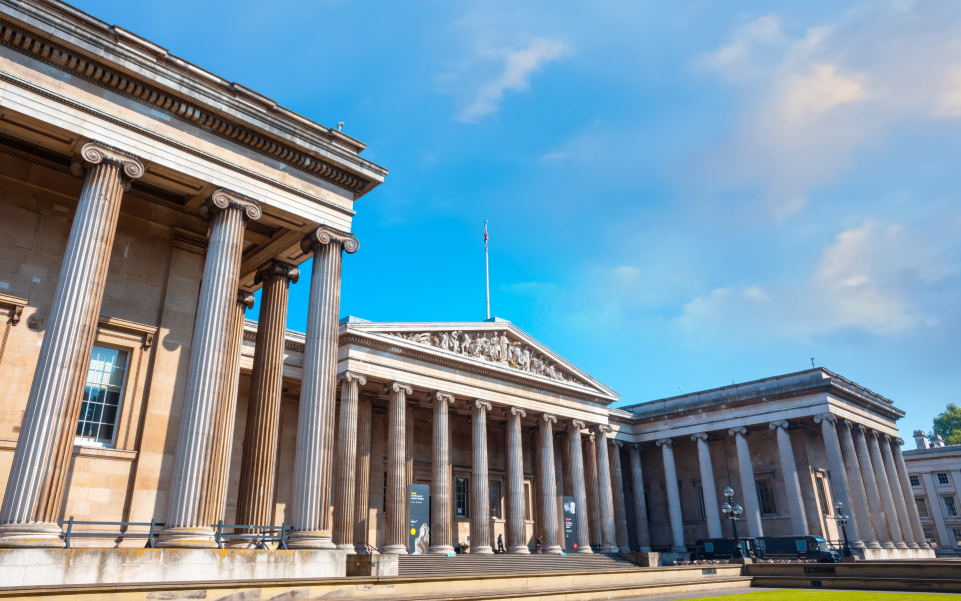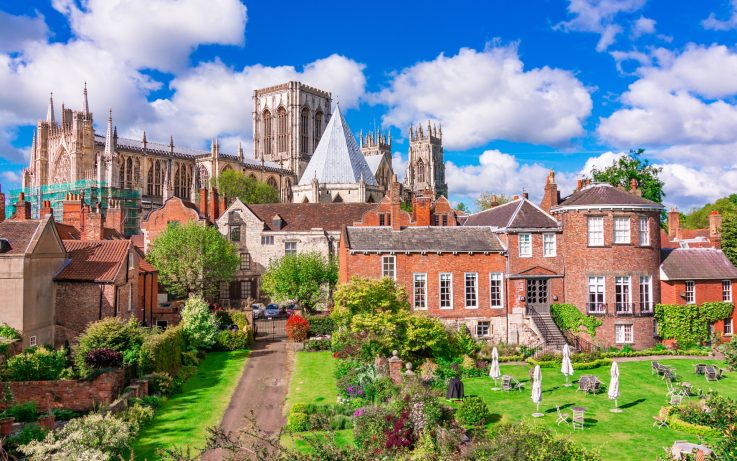The British Museum: a rich collection of priceless artefacts

One of the most influential and interesting historical and archaeological museums in the world is the British Museum. Thanks to it, you can take a fascinating journey through the heritage of mankind, as it houses more than 8 million exhibits! You will see unique monuments from all six continents, including both masterpieces of art and amazing finds that are over two million years old. And to make your acquaintance with the museum more complete, we will tell you a little about its history.
The creation of the British Museum
As far back as 1753, by the will of the physician Sir Hans Sloan, his vast and varied collection of rare objects and books was given to King George II. This was, of course, a very large and important national contribution to the country. To comply with the terms of the will, Sloane’s heirs were to receive £20,000 from the state and all artefacts were to be displayed in a new museum accessible to all. The arrangements were honoured, the Cotton and Harley Libraries, the Royal Libraries and the British Museum were added to the collection and on 7 June 1753, by Act of Parliament, the British Museum was established. Remarkably, by then it had become the world’s first free national public museum.
At first, the entire valuable collection was housed in Montagu House. It was first presented to the public in 1759, after the mansion had been restored. By 1823, however, the collection had grown so large that a new, more spacious building was built on the site. In 1852, under the direction of the architect Sir Robert Smirke, it was completed, becoming a grand and iconic structure. Even today we can still climb its steps and admire the Greek Revival architecture. The portico with colonnade, which is now so recognisable all over the world, also became an ornament of the museum. On the pediment, expressive sculptures depict the “Progress of Civilisation”, reflecting how mankind developed from primitive to enlightened in eight stages.
Inside the museum, the circular room with a huge dome, located in the middle of the Great Courtyard, immediately attracts attention. It appeared in 1857, becoming one of the most famous reading rooms in the world. Its library occupied as much as 4.8km of cabinets and 40km of shelves, which eventually served to get a separate building on St. Pancras in 1997. The vacated space, with so much history, now houses the museum’s archive and library, whose research materials are essential for students and researchers.
The Grand Courtyard itself, of course, makes a grand impression with its modern roof of glass panels. It turns out that there are 3312 of them and each one is unique in its shape. And if a tower could be created out of 6 London buses, it would touch the furthest panel, which is more than 26 metres from the floor. Now it’s hard to imagine that this was originally just an ordinary building courtyard, unprotected from the weather. All that changed was a large-scale reconstruction, which gave this place new landscaped areas. Thanks to it, in 2000 the total area of the museum increased by 40 per cent and the courtyard became the largest of its kind in Europe. It received the honour of being named after Queen Elizabeth II, and the monarch honoured the opening ceremony with a visit.
The British Museum’s most famous exhibits
Among the huge number of artefacts, there are certainly some particularly famous specimens and we will have time to tell you about just a few of them.
For example, the Rosetta Stone is a part of a stone slab from 196 BC, which is of great scientific value in Egyptology. It is thanks to it that experts were finally able to decipher the mysterious Egyptian hieroglyphs. They wrote one of the three parts of the message, which has the same meaning, but written in three different languages. And since two of them – Demotic writing and Ancient Greek, were already known to scientists, they served as a key to understanding the hieroglyphs. The stone was found in 1799 and has been kept in the museum since 1802 – just imagine how many people have already seen it!
You can’t pass by without noticing the huge bust of Ramses II, which is almost 267 cm high. Its weight is over 7 tonnes and, remarkably, it is a solid piece of two-coloured granite. This natural feature of the stone enhances the effect of perception, emphasising the separation of the legendary pharaoh’s face and body. In addition, the hieroglyphs on the reverse side of the monument complement its image, leaving a vivid impression on the viewers.
You will also see the very mummy Catebet with a gilded mask-like face, which is complemented by an exquisite wig and white earrings. Her arms are crossed on her chest, her fingers are decorated with real rings, there is a sparrow beetle on her stomach and a small statuette in the form of a mummy (shabti) at knee level. This characteristic image is widely known, thanks to numerous publications. It is so well preserved that you will be surprised to learn that it is over 3,300 years old!
The museum’s Egyptian collection as a whole is also one of the largest outside Egypt. It includes a variety of mummies, statues and sarcophagi, an outstanding collection of papyri, fragments of fine paintings from tombs and many other objects that allow you to immerse yourself in this ancient and mysterious world.
The collection of artefacts from Ancient Greece is undoubtedly of great interest. The grandeur of the Parthenon is conveyed by numerous sculptures from its pediments, priceless friezes and metopes, and other architectural masterpieces. All of them are also known as the “Elgin Marbles”, after the name of the lord who brought them in the early 19th century. The hall with the famous dynamic sculptures of the sea nymphs Nereid and the recreated tomb monument in the form of a Greek temple are also memorable.
When looking at a collection of various Ancient Roman objects, many people notice and admire the Portland Vase. It impresses with its skilful relief carving on opaque white glass. The contrast with the dark cobalt translucent glass further emphasises the subtle details of the pattern and subject matter.
Particularly noteworthy is the display of various items from a ship buried as early as the early 600s AD in one of the barrows at Sutton Hoo. It was discovered in 1939 in Suffolk County and the many artefacts revealed important information about the previously unknown history of 7th century Britain. In the centre of the ship was a burial chamber with sumptuous treasures and most experts believe they were owned by an Anglo-Saxon king. Among the weapons and exquisite jewellery, the main exhibit is a skilfully made helmet with a mask. In the museum you will see its reconstructed copy richly decorated with ornaments. Particular attention is drawn to the front part, because the nose is like the body of a bird, its wings form the brow arches, and the tail is in place of the warrior’s moustache. Many people do not notice that there is also a lynx – with its jaws it as if finishes the wings of the bird, and already on the frontal part there is a dragon, whose jaws are open towards the bird. You can learn a lot about their symbolism and about the burial site as a whole. A novel has been written about this most important archaeological discovery and a feature film has been made.
Continuing the theme of jewellery is the famous Gold Cloak. This impressive work was created from gold leaf during the British Bronze Age (1900-1600 B.C.) It is particularly remarkable for its unparalleled form and design. Its intense decoration imitates fabric and the numerous strands of beads amongst it. It is thought to have been worn only during religious ceremonies, as it is not easily worn in everyday life.
For a while, you can also be transported to Easter Island by being near a large stone sculpture or moai from there. It is called Hoa Hakananaia, which can be translated as, “lost or stolen friend”. This statue probably appeared somewhere between 1000 and 1200 AD and is unique in that it is one of only 14 carved from basalt. Other similar statues, and there are about 887 of them, were created from a softer material – volcanic tuff. The sculpture weighs about 4.2 tonnes and looks very laconic, even mysterious. At the same time, if you look at its back side, you will see unusual reliefs. With the help of petroglyphs, the islanders, the Rapa Nui, depicted their religion associated with the bird-man. And now imagine that originally these patterns were red and white, and the eye sockets were decorated with red stone and coral. Yes, such an image is different from what we are used to! And that’s exactly what the statue was in 1869 when it was transported by ship to Europe until it was transformed by water.
The museum also houses Lewis’s famous chess pieces. They are memorable for their own style of carving, characteristic facial expressions and ornaments. And you will surely remember them if you watched the first Harry Potter film – one of the scenes used an exact copy of them. The figures themselves were discovered as part of a treasure trove in 1831 and named after the island of the same name. A total of 93 pieces were found and 82 of them can be seen in a British museum. For most of them walrus bone was used as material, but for some of them whale tooth was used. They are thought to have been carved in 12th century Norway, and the Isle of Lewis was then just part of that kingdom.
In one of the museum’s halls you will also see a spectacular pectoral from Mexico – a two-headed snake. The basis for its bizarre shape was Spanish cedar, which was decorated with numerous pieces of turquoise. The heads with open toothy mouths and the red edging give it a menacing appearance suitable for use in ritual rites of the 15th-16th centuries.
So you’ve been introduced to the British Museum’s most iconic exhibits, and we’ll have time to talk a bit about its educational activities as well.
Educational programmes at the British Museum
Informative lectures and a variety of masterclasses, exhibitions and cultural events are all available and constantly updated at the museum. In addition, there are many conferences, training courses and debates in which you can participate. The museum has special educational programmes for schoolchildren, as well as special classes for families with children of all ages. If you wish, you can join the museum’s club and enjoy a wide range of benefits.
The British Museum’s collection is still growing, so there is always something new to see. There is no doubt that its wealth and rich cultural life helps many people to fulfil their potential even more!
FAQs about the British Museum
How and when can I visit the British Museum?
Entrance to the museum, since its opening, has always been free of charge. However, it should be remembered that the British Museum is one of the most popular attractions in London and the number of visitors is limited to ensure a comfortable stay.
Therefore, we recommend booking tickets in advance for both the permanent exhibition and individual exhibitions. It is easy to do this online on the museum’s website.
Opening hours: daily from 10:00 to 17:00, on Friday until 20:30.
For the convenience of visitors, there is also a restaurant, café, pizzeria and shops offering a wide variety of souvenirs and books related to the museum.
Can private individuals hire the British Museum premises and hold events?
The British Museum has a number of modern meeting rooms that can be used for a variety of daytime and evening meetings. For example, one of these is equipped with a stage, pulpit and large digital projector, which can be a great place for a AGM, presentation or press conference. There is also a smaller room and also with a screen that can be used for speeches, award ceremonies and premieres. The museum’s dedicated team can help organise a separate foyer for registration, exhibition stands, serving refreshments and much more for these occasions. The museum also has other spaces for meetings and sessions, receptions and lunches. You are always welcome to contact the museum administration to inquire about potential opportunities.
Is it possible to order branded gifts from the British Museum?
If exclusive and original souvenirs are required for your company, the British Museum has the ability to fulfil such an order. A company logo, personal message and any other design solution can be used. When choosing a theme, do not forget that the museum has copies of sculptures and artefacts, which will distinguish your corporate gifts from others. Souvenirs can be designed in personalised branded packages, which are perfect for business events. Undoubtedly, such memorable gifts will have a special meaning and will be remembered for a long time.






